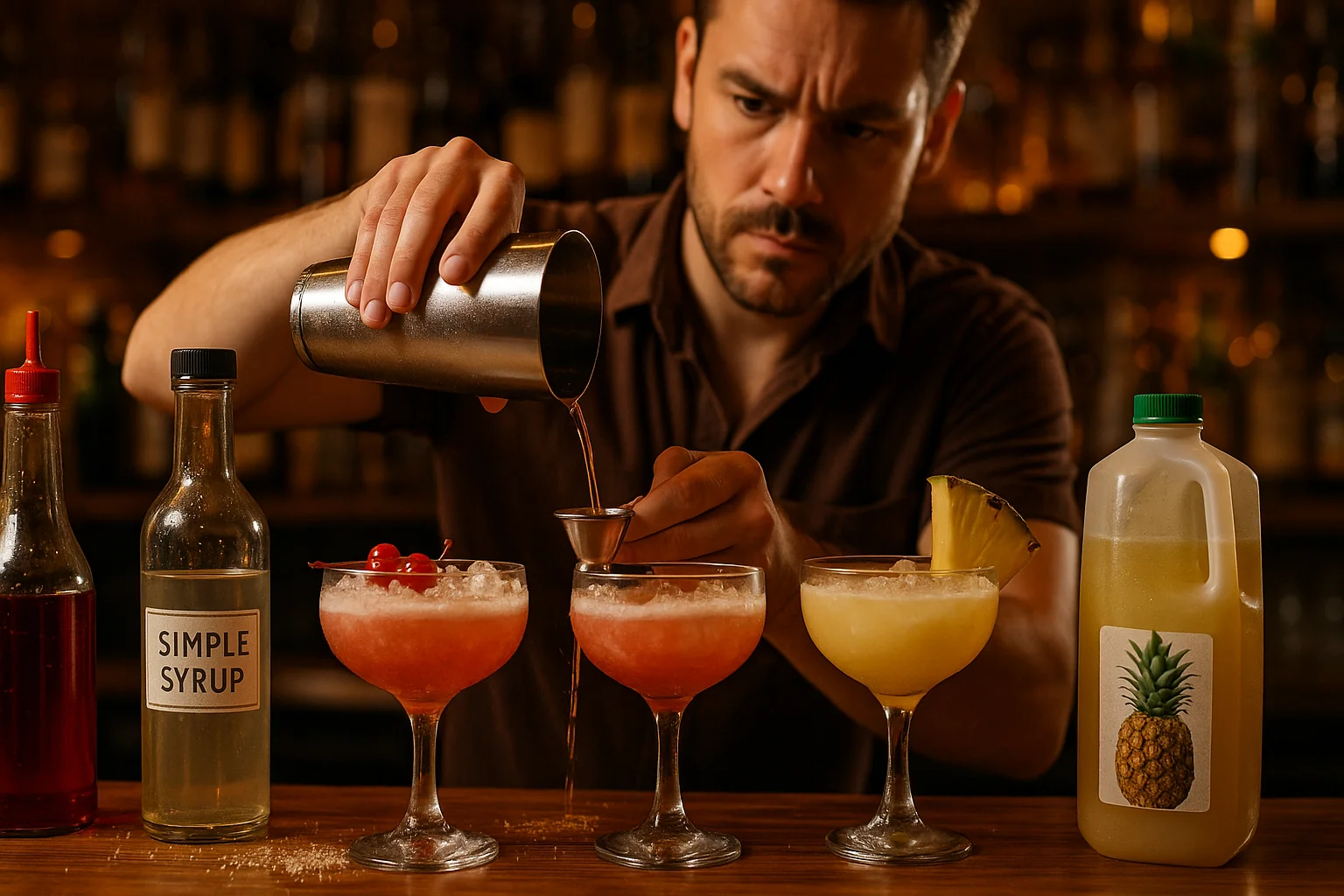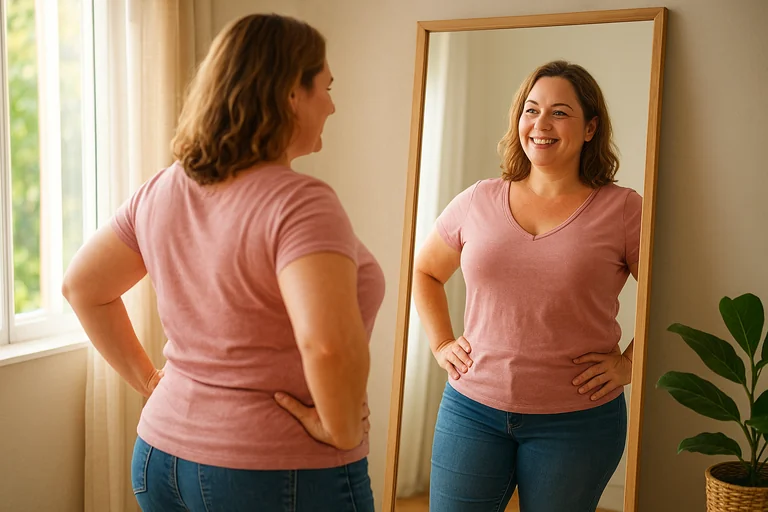A 2 minute assessment to get a personalized mental health or alcohol recovery plan.
Liquor can lead to weight gain depending on how much, how often, what you mix it with, and what happens after you drink (late-night eating, sleep loss), because alcohol delivers about 7 kcal per gram and the body burns alcohol first while temporarily shutting down fat burning and favoring fat storage.
What You'll Discover:
- Why alcohol's 7 kcal per gram adds up faster than most people realize
- How liquor suppresses fat burning and shifts metabolism toward storage
- Why mixers can turn a shot into a calorie bomb with added sugars
- Mixed evidence on moderate drinking and why heavy patterns consistently drive weight gain
- Practical strategies to enjoy liquor without weight gain
- Evidence-based treatment options including naltrexone when cutting back is difficult
Alcohol is energy-dense at about 7 kcal per gram, second only to fat (9 kcal/g), so liquor adds significant calories fast. Calories from liquor are "empty," they come with little to no nutrients, and your body burns alcohol first, temporarily shutting down fat burning and favoring fat storage after drinking.
Mixers matter. Sugary sodas, juice, syrups, and cream liqueurs can turn a shot into a dessert; public-health guidance recommends limiting added sugars to avoid weight gain.
All that said, heavy or frequent drinking patterns are consistently tied to weight gain; light-to-moderate patterns show mixed findings because behavior (diet, activity, sleep) differs across people.
With that in mind, here's exactly how liquor affects your weight, what the research shows, and how to enjoy spirits without creeping weight gain.
Why alcohol can push weight up even when it's just a couple of drinks
Alcohol (ethanol) carries about 7 kcal per gram. That's nearly as calorie-dense as fat and more than protein or carbs (both about 4 kcal/g). Liquor itself is mostly ethanol plus water; straight spirits don't contain much carbohydrate, but the ethanol calories still count, and the mixers often add a lot more. Public-health and clinical sources emphasize the energy density of alcohol and the tendency to underestimate drink calories.
Two mechanisms make liquor particularly sneaky for weight.
Metabolic priority - Your body treats ethanol like a toxin and burns it first. Studies using indirect calorimetry show that when alcohol is on board, the body suppresses fat oxidation, so dietary fat is stored rather than burned. In classic trials, adding or substituting alcohol at a meal reduced whole-body lipid oxidation for hours.
Downstream effects - Alcohol can disinhibit eating, fragment sleep (driving next-day hunger and cravings), and raise total intake via snacks or late-night meals. Experimental and review data link alcohol to disturbed sleep homeostasis; short or disturbed sleep is tied to higher appetite and weight gain.
Bottom line: A few 1.5-oz pours may look small, but their calories add up quickly, especially with mixers, and they push your metabolism toward storage after drinking.
Liquor versus beer versus wine - does type matter for weight
For body weight, the relevant number is total ethanol calories (plus whatever else comes with the drink). A standard drink in the U.S. contains about 14 g of pure alcohol, whether it's 1.5 oz of 80-proof spirits, 5 oz of wine, or 12 oz of 5 percent beer, so the ethanol calories are similar across types at standard sizes. What often differs are the extras: carbs in beer, residual sugar in some wines, and mixers in cocktails.
Neat or on the rocks (spirits): Primarily ethanol calories; impact depends on how many pours. Classic cocktails: Add syrups, juice, soda, often 100 to 300 plus extra kcal per drink. Public-health guidance encourages limiting added sugars. "Light" beers or dry wines: Fewer non-alcohol calories per serving, but the ethanol calories still accumulate with multiple rounds.
Epidemiology is mixed at lighter intake levels, partly because people who drink lightly may also have healthier overall habits, but heavy or regular intake is much more consistently associated with weight gain and obesity risk over time.
How many calories are we really talking about
Use standard drinks to estimate. In the U.S., 1 standard drink equals 14 g ethanol. Depending on proof and pour size:
1.5 oz (44 ml) of 80-proof liquor equals about 1 standard drink (ethanol calories about 98 kcal; total may be slightly higher depending on brand). A simple mixed drink (1.5 oz spirit plus 6 to 8 oz regular soda/juice) can easily reach 180 to 250 plus kcal. A craft cocktail with syrups, liqueurs, cream, or multiple pours can exceed 300 to 500 kcal. (Alcohol is 7 kcal/g, mixers add carbohydrate/fat calories.)
Multiply this by frequency (2 to 3 cocktails per outing, 2 to 3 outings per week), and you can see how liquor-based drinks alone can add hundreds to thousands of calories monthly, even before the late-night tacos.
The after-effects - how liquor influences hunger, choices, and sleep
Appetite and food choices - Alcohol can increase appetite and reduce dietary restraint, pushing choices toward energy-dense foods. Some human studies suggest complex effects on appetite hormones; what's most consistent is the behavioral outcome, more food after drinking.
Sleep and next-day intake - Alcohol may help you fall asleep faster, but it disrupts sleep homeostasis and REM later in the night. Poor sleep relates to increased hunger and snack intake the next day, creating a loop of more calories overall.
Activity trade-offs - Next-morning fatigue often means shorter workouts or skipped sessions, lowering energy expenditure and momentum.
Put together, you get a calorie sandwich: intake during drinking (ethanol plus mixers) plus intake after drinking (snacks/meals), with less fat burning in the middle, and sometimes less activity the next day.
Is liquor worse than beer or wine for belly fat
"Beer belly" is a catchy phrase, but visceral fat responds to energy surplus and hormonal/metabolic dynamics, not labels like "beer" or "liquor." Since ethanol calories are similar per standard drink, the pattern (binges versus paced), the mixers, and the total number of drinks drive risk more than type. Also, weight gain and alcohol together amplify liver risk; studies suggest BMI and alcohol interact to increase risk of alcohol-related liver disease (the combination is worse than either alone).
What the research says (and why it seems contradictory)
Systematic reviews show that heavy/frequent intake aligns with weight gain and obesity risk. Light-to-moderate intake shows heterogeneous results, some cohorts show maintenance or even lower weight, likely influenced by lifestyle confounding (diet quality, activity, socioeconomic factors).
Experimental studies clarify mechanisms: alcohol reduces fat oxidation during metabolism and can promote fat storage when consumed with or after meals. Over time, these effects add up if calories aren't reduced elsewhere.
Translation: If you're trying to manage weight, the safest assumption is that liquor adds calories, often triggers more eating, and tilts metabolism toward storage, so it's easier to gain and harder to lose.
Practical strategies if you enjoy liquor but don't want weight gain
Control the dose - Anchor to standard drinks (1.5 oz of 80-proof spirits equals 1 drink). Decide before you go how many you'll have (1 to 2), then stick to it. Pour at home with a jigger. Tall glasses hide doubles.
Choose lower-calorie constructions - Go neat, rocks, or with soda water plus citrus; avoid sugar-dense mixers (colas, tonic, juice blends, syrups, creamy liqueurs). Public-health guidance: limit added sugars. If you like cocktails, favor dry templates (highball with soda, spirit plus bitters plus twist) over dessert-style builds.
Pace and protect sleep - Keep to 1 drink or less per hour and eat first (protein plus fiber slows absorption and helps appetite control). Cut off early (2 to 3 hours before bed) to reduce sleep disruption and next-day cravings. Alcohol impairs sleep homeostasis, shortening late-night REM and provoking early awakenings.
Plan the after-drinking window - Pre-commit non-food wind-down rituals (decaf tea, shower, short walk, music) and set aside a satisfying, planned snack if you know you'll want one, avoid the 1 a.m. takeout decision. Schedule morning movement with a friend to protect next-day activity.
Audit the weekly tally - A weekly review of drinks, mixers, and late-night calories reveals the true impact. Small changes (swapping two sugary cocktails for a soda-water highball and one neat pour) can save hundreds of kcal/week.
What if you want to reduce how much you drink
You don't have to go it alone. Clinicians routinely help people right-size alcohol for health and weight goals. Brief counseling can map triggers, set limits, and build skills for social situations. For many adults who are medically appropriate, naltrexone oral tablets used alongside counseling can reduce heavy-drinking days and craving, which often makes calorie control and sleep routines easier to maintain. Clinicians check for contraindications (current opioid use/dependence, acute hepatitis/liver failure) and may obtain liver tests before/during treatment.
Important: If you take any opioid medication, tell your clinician before starting naltrexone to avoid precipitated withdrawal.
Frequently asked questions
If liquor has no carbs, why would it cause weight gain? - Because ethanol calories still count, and at 7 kcal/g they're dense. Plus, alcohol reduces fat burning for hours after intake, so dietary fat is more likely to be stored. Mixers often add a big sugar load.
Is vodka better than whiskey for weight? - Not meaningfully. At the same standard pour, ethanol calories are similar. Choose based on fewer drinks and low-sugar mixers rather than brand or spirit type.
What about moderation - won't one drink a day be fine? - Guidance is shifting toward lower is better given broad health risks. For weight, even "moderate" intake can slow fat loss if it adds calories you don't subtract elsewhere or if it increases snacking and sleep loss.
Can I just work off the calories? - Exercise helps health and energy balance, but alcohol's metabolic effects (reduced fat oxidation, sleep disruption) can undercut your efforts. It's easier to meet goals by reducing intake and choosing low-sugar builds than by trying to outrun cocktails.
Is weight gain from liquor worse for my liver? - Excess body fat and alcohol compound liver risk. Prospective studies show raised BMI plus alcohol interact to raise liver disease risk more than either alone.
Ready to understand where you stand?
Curious whether your drinking pattern is adding hidden calories or edging into risky territory? Our quick, confidential alcohol assessment gives you a private, research-based readout you can share with your clinician, plus personalized guidance on safer next steps.
Start your 3-minute alcohol use assessment




